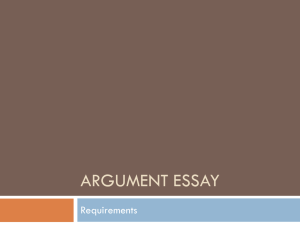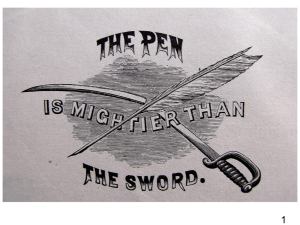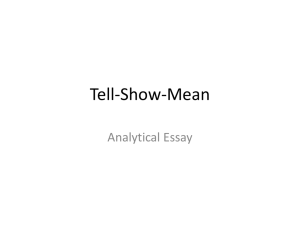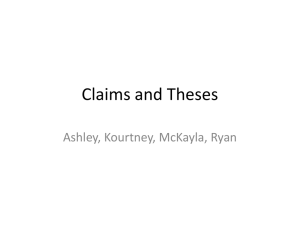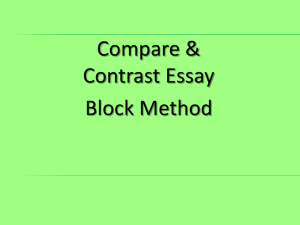Argument Essay - Venice High School
advertisement
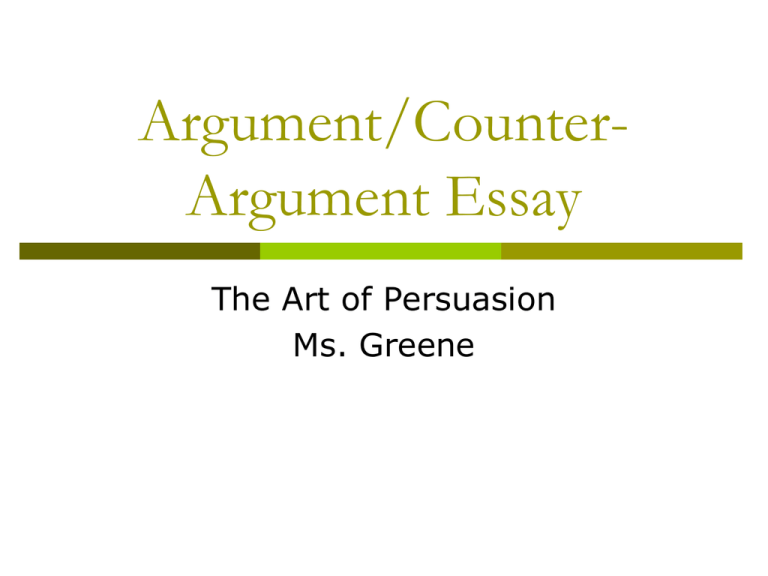
Argument/CounterArgument Essay The Art of Persuasion Ms. Greene CHOOSING A TOPIC To begin an argumentative/persuasive essay, you must first have an opinion you want others to share. You will develop a thesis statement that can be argued. Research-Gather Data to Support Your Claim/Thesis To be valid, an opinion or point of view must be supported by facts and information. Once you know what you will write about, you will need to do research on the topic. Research through interviewing people, or reading newspaper, book, journal or Internet articles. Use appropriate web sites Make sure your experts are valid Prepare your Works Cited page and your parenthetical citations (Source Notes) in advance THESIS STATEMENT states your position on the topic sets up the structure for the paper can be argued SUPPORT THE THESIS Support your thesis with at least two reasons. Write down each of the reasons that support your belief on a separate piece of paper. These are your arguments and are the blueprints for your paper. COUNTER-ARGUMENTS Every controversial issue has two sides. Once you can support your position with research, you need to explore what others think. If you do not address the opposition to your argument, and explain why your opinion is more valid, you will weaken your own argument. PREPARING YOUR ARGUMENTS Look at the main reasons for your opinion. What objections would others have to each of your reasons? Write these down under each of your reasons. Now you have arguments and counter-arguments. ANSWERING COUNTERARGUMENTS Write your answers down under the counter-arguments. Now you have the raw material for each paragraph of the argumentative essay. THE AUDIENCE Before writing and introducing the topic, think about the audience first. How much does the audience know about the topic? Is the audience likely to be friendly or hostile to your position? How can you “hook” the audience’s attention? INTRODUCTION PARAGRAPH The first sentence is a general statement, designed to attract the reader’s attention and “hook” the reader in. Provide background information to orient the reader to the issue What does the reader need to know about this issue? Define terms Create a thesis statement or assertion to guide the reader More Introduction: Think of the introduction as having a funnel shape: Developing a Thesis Statement Arguable or Not Arguable? Marijuana should be legalized. Arguable Smoking cigarettes is harmful to people’s health. Fatburger sells the best burgers in Los Angeles. Not Arguable Arguable Emissions hurt the ozone. Not arguable Developing the Thesis: You may want to “brainstorm” before developing your thesis Conversely, you may want to think of your thesis before you brainstorm. In any case, you will need to create a brainstorm before you write your paper. Sample Graphic Organizer Brainstorm Format: Chart Topic: Should marijuana be legalized? Pro Con OTHER TYPES OF BRAINSTORMING: Listing Mind Map Webbing Venn Diagrams Note taking Free-writing Clustering Drawing BUILDING BODY PARAGRAPHS The first topic sentence of the first body paragraph will be the first reason that supports your position. The topic sentence of the second body paragraph . will be the second reason that supports your position Repeat these steps as necessary. The topic sentence of one of the body paragraphs will address the counter argument. Body Paragraphs Provide a clear topic sentence for each paragraph Contain quotations and evidence that help prove the thesis of the essay. Include explanation of how the quotations back up the thesis. Build to the strongest argument Use a variety of appeals Demonstrate logic and reasoning Address the opposition Types of Appeals Review - Logos, Pathos, and Ethos – to use in the content of your essay: Logos-logical appeal Evidence and the reasoning based on that evidence Ethos-ethical appeal According to Aristotle--the credibility or trustworthiness that the author establishes in his writing Pathos-Emotional appeal Persuades the audience by using emotions The Antithesis Address the case of the opposition Concede points which can not be refuted Several paragraphs at the beginning or weaved throughout the paper (argument-concession) Use signal words and phrases such as Admittedly, While it is true that etc. Offer refutation for claims which can be countered Use signal words and phrases such as It has been argued, However etc. Conclusion Restate your main premise Provide a brief summary of your argument Show how a group will benefit from following your assertion Explain what might happen if your idea is not accepted End with a rhetorical question Ask for a call to action Rough Outline; It is a good idea to complete a rough outline of your essay before writing: A. INTRO: Hook Background Information Thesis Three reasons that support your position (may be included in the thesis) Body Paragraphs Rough Outline: B. Body – paragraphs 1 – however many you need. 1. 1st reason a. quotation/example b. explanation c. quotation example d. explanation e. concluding sentence typing what you are proving to the thesis or to transition to the next paragraph. For the counter argument, you will list an opposing viewpoint instead of a reason. Overview of an Argument Essay attention getter organization antithesis—con refute the con connective words—transitions development of arguments conclusion


